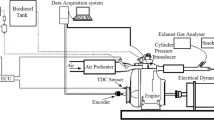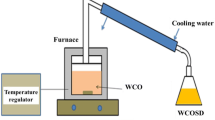Abstract
This paper intends to study the combustion, performance and emission characteristics of the HCCI-DI engine with waste cooking oil (WCO) biodiesel as direct injection fuel and diesel/gasoline as the premixed fuel. 20% of fuel (gasoline/diesel) was injected at inlet manifold along with the intake air during the suction stroke. Balance 80% of the fuel (diesel, B50 and WCO) was injected into the cylinder at 23 °CA before TDC. The outcomes observed from the experimentations showed that the HCCI-DI engine was resulted increased brake thermal efficiency (ηbth) than conventional DI engine. Increase in the ηbth up to 4.23% was found form the gasoline-premixed HCCI-DI operation compared to DI operation. During HCCI-DI, 14.81% and 4.3% drop in oxides of nitrogen (NOx) were observed for the diesel and gasoline premixing, respectively, compared to conventional engine. A decrease in the hydrocarbon up to 54.17% was noted for the WCO-fuelled DI engine compared with diesel-fuelled DI engine. 50.66% and 39.21% reduction in the smoke emissions were found for the diesel and gasoline-premixed HCCI-DI, respectively, compared to diesel-fuelled DI engine. Artificial neural network modelling was proposed to forecast the emissions and ηbth of the HCCI-DI engine.








Similar content being viewed by others
Abbreviations
- P :
-
Cylinder pressure (bar)
- m :
-
Number of data set
- R :
-
Correlation coefficient
- R 2 :
-
Coefficient of determination
- O 2 :
-
Oxygen
- η bth :
-
Brake thermal efficiency
- θ RoHRmax :
-
Crank angle corresponding RoHRmax
- θ pmax :
-
Crank angle corresponding Pmax
- t:
-
Actual observation
- n:
-
Crank angle interval (°CA)
- o:
-
Predicted output value
- max:
-
Maximum
- ANN:
-
Artificial neural network
- ASTM:
-
American society for testing and materials standard
- CI:
-
Compression ignition
- CO:
-
Carbon monoxide
- CZO:
-
Copper-doped zinc oxide
- DI:
-
Direct injection
- HC:
-
Hydrocarbon
- HCCI:
-
Homogeneous charge compression ignition
- RoHR:
-
Rate of heat release
- IC:
-
Internal combustion
- MAPE:
-
Mean absolute percentage error
- NOx:
-
Oxides of nitrogen
- NRMSE:
-
Normalized root-mean-square error
- RPR:
-
Rate of pressure rise (bar °CA−1)
- SFC:
-
Specific fuel consumption
- SI:
-
Spark ignition
- SOC:
-
Start of combustion
References
BP Statistical Review of World Energy, 2018. Retrieved from https://www.bp.com/content/dam/bp/business-sites/en/global/corporate/pdfs/energy-economics/statistical-review/bp-stats-review-2018-full-report.pdf.
Elumalai PV, Annamalai K, Dhinesh B. Effects of thermal barrier coating on the performance, combustion and emission of DI diesel engine powered by biofuel oil–water emulsion. J Therm Anal Calorim. 2018;137(2):593–605.
Venkatesan EP, et al. Performance and emission reduction characteristics of cerium oxide nanoparticle-water emulsion biofuel in diesel engine with modified coated piston. Environ Sci Pollut Res. 2019;26(26):27362–71.
Dhinesh B, Annamalai M. A study on performance, combustion and emission behaviour of diesel engine powered by novel nano nerium oleander biofuel. J Clean Prod. 2018;196:74–83.
Yang PM, Wang CC, Lin YC, Jhang SR, Lin LJ, Lin YC. Development of novel alternative biodiesel fuels for reducing PM emissions and PM-related genotoxicity. Environ Res. 2017;156:512–8.
Guerrero CA, Guerrero-Romero A, Sierra FE. Biodiesel production from waste cooking oil. Biodiesel—Feedstocks and processing technologies. In: InTech, 2011.
Prabu SS, Asokan MA, Roy R, Francis S, Sreelekh MK. Performance, combustion and emission characteristics of diesel engine fuelled with waste cooking oil biodiesel/diesel blends with additives. Energy. 2017;122:638–648.
Kalam MA, Masjuki HH, Jayed MH, Liaquat AM. Emission and performance characteristics of an indirect ignition diesel engine fuelled with waste cooking oil. Energy. 2011;36(1):397–402.
Gopal KN, Pal A, Sharma S, Samanchi C, Sathyanarayanan K, Elango T. Investigation of emissions and combustion characteristics of a CI engine fueled with waste cooking oil methyl ester and diesel blends. Alex Eng J. 2014;53(2):281–7.
Mazumdar B, Agarwal AK. Performance, emission and combustion characteristics of biodiesel (waste cooking oil methyl ester) fueled IDI diesel engine. SAE Technical Paper. 2008.
Onishi S, Jo SH, Shoda K, Jo PD, Kato S. Active thermo-atmosphere combustion (ATAC)—a new combustion process for internal combustion engines. SAE Technical Paper 790501, 1979. https://doi.org/10.4271/790501.
Noguchi M, Tanaka Y, Tanaka T, Takeuchi Y. A study on gasoline engine combustion by observation of intermediate reactive products during combustion. SAE Technical Paper 790840, 1979. https://doi.org/10.4271/790840.
Christensen M, Hultqvist A, Johansson B. Demonstrating the multi fuel capability of a homogeneous charge compression ignition engine with variable compression ratio. SAE Technical Paper; 1999. p. 1999-01–3679.
Aoyama T, Hattori Y, Mizuta J, Sato Y. An experimental study on premixed-charge compression ignition gasoline engine., SAE Technical Paper SeriesWarrendale: SAE International; 1996.
Nishi M, Kanehara M, Iida N. Assessment for innovative combustion on HCCI engine by controlling EGR ratio and engine speed. Appl Therm Eng. 2016;99:42–60.
Zheng J, Caton JA. Effects of operating parameters on nitrogen oxides emissions for a natural gas fueled homogeneous charged compression ignition engine (HCCI): Results from a thermodynamic model with detailed chemistry. Appl Energy. 2012;92:386–94.
Jung D, Iida N. Closed-loop control of HCCI combustion for DME using external EGR and rebreathed EGR to reduce pressure-rise rate with combustion-phasing retard. Appl Energy. 2015;138:315–30.
Krishnan SR, Srinivasan KK, Raihan MS. The effect of injection parameters and boost pressure on diesel-propane dual fuel low temperature combustion in a single-cylinder research engine. Fuel. 2016;184:490–502.
Ying W, Li H, Jie Z, Longbao Z. Study of HCCI-DI combustion and emissions in a DME engine. Fuel. 2009;88(11):2255–61.
Das P, Selokar M, Subbarao PMV, Subrahmanyam JP. Effect of injection timing, premixed equivalence ratio and EGR on combustion characteristics of an HCCI-DI combustion engine using in-cylinder dual injection strategy., SAE Technical Paper SeriesWarrendale: SAE International; 2016.
Thiyagarajan S, Sonthalia A, Geo VE, Prakash T, Karthickeyan V, Ashok B, Nanthagopal K, Dhinesh B. Effect of manifold injection of methanol/n-pentanol in safflower biodiesel fuelled CI engine. Fuel. 2020;261:116378.
Zhao Y, Wang Y, Li D, Lei X, Liu S. Combustion and emission characteristics of a DME (dimethyl ether)-diesel dual fuel premixed charge compression ignition engine with EGR (exhaust gas recirculation). Energy. 2014;72:608–17.
Mohanraj M, Jayaraj S, Muraleedharan C. Applications of artificial neural networks for refrigeration, air-conditioning and heat pump systems: a review. Renew Sustain Energy Rev. 2012;16(2):1340–58.
Mohanraj M, Jayaraj S, Muraleedharan C. Applications of artificial neural networks for thermal analysis of heat exchangers: a review. Int J Therm Sci. 2015;90:150–72.
Kamar HM, Ahmad R, Kamsah NB, Mustafa AF. Artificial neural networks for automotive air-conditioning systems performance prediction. Appl Therm Eng. 2013;50(1):63–70.
Hosoz M, Ertunc HM. Artificial neural network analysis of an automobile air conditioning system. Energy Convers Manag. 2006;47(11–12):1574–87.
Ceylan I, Aktaş M. Modeling of a hazelnut dryer assisted heat pump by using artificial neural networks. Appl Energy. 2008;85(9):841–54.
Hojjat M. Nanofluids as coolant in a shell and tube heat exchanger: ANN modeling and multi-objective optimization. Appl Math Comput. 2020;365:124710.
Gupta AK, Kumar P, Sahoo RK, Sahu AK, Sarangi SK. Performance measurement of plate fin heat exchanger by exploration: ANN, ANFIS, GA, and SA. J Comput Des Eng. 2017;4(1):60–8.
Verma TN, Nashine P, Singh DV, Singh TS, Panwar D. ANN: Prediction of an experimental heat transfer analysis of concentric tube heat exchanger with corrugated inner tubes. Appl Therm Eng. 2017;120:219–27.
Chakraborty A, Roy S, Banerjee R. An experimental based ANN approach in mapping performance-emission characteristics of a diesel engine operating in dual-fuel mode with LPG. J Nat Gas Sci Eng. 2016;28:15–30.
Taghavifar H, Mardani A, Mohebbi A, Taghavifar H. Investigating the effect of combustion properties on the accumulated heat release of di engines at rated EGR levels using the ANN approach. Fuel. 2014;137:1–10.
Javed S, Murthy YS, Baig RU, Rao DP. Development of ANN model for prediction of performance and emission characteristics of hydrogen dual fueled diesel engine with Jatropha Methyl Ester biodiesel blends. J Nat Gas Sci Eng. 2015;26:549–57.
Leo GL, Sekar S, Arivazhagan S. Experimental investigation, optimization and ANN model prediction of a gasoline premixed waste cooking oil fueled HCCI–DI engine. J Braz Soc Mech Sci Eng. 2018;40(2):49.
Lionus LG, Subramani S, Sundaraganesan A. Experimental investigation, ANN modelling and TOPSIS optimization of a gasoline premixed HCCI-DI engine with direct injection of FeCl3 nanodditive blended WCO. Trans FAMENA. 2019;43(3):83–100.
Ramalingam K, et al. Forcasting of an ANN model for predicting behaviour of diesel engine energised by a combination of two low viscous biofuels. Environ Sci Pollut Res. 2019. https://doi.org/10.1007/s11356-019-06222-7.
Gurunathan B, Ravi A. Biodiesel production from waste cooking oil using copper doped zinc oxide nanocomposite as heterogeneous catalyst. Bioresour Technol. 2015;188:124–7.
Gan S, Kiat H, Mun K. Homogeneous charge compression ignition (HCCI) combustion: implementation and effects on pollutants in direct injection diesel engines. Appl Energy. 2011;88(3):559–67.
Can Ö. Combustion characteristics, performance and exhaust emissions of a diesel engine fueled with a waste cooking oil biodiesel mixture. Energy Convers Manag. 2014;87(2014):676–86.
Selvam DJP, Vadivel K. An experimental investigation on performance, emission, and combustion characteristics of a diesel engine fueled with methyl esters of waste pork lard and diesel blends. Int J Green Energy. 2013;10(9):908–23.
Hussaini SY, Lahane S, Patil NG. Analysis of performance and emission characteristics of a homogeneous charge compression ignition (HCCI) engine. Procedia Technol. 2016;25:854–61.
Yeom K, Bae C. Gasoline-di-methyl ether homogeneous charge compression ignition engine. Energy Fuels. 2007;21(4):1942–9.
Barik D, Murugan S. Experimental investigation on the behavior of a DI diesel engine fueled with raw biogas–diesel dual fuel at different injection timing. J Energy Inst. 2016;89(3):373–88.
Enweremadu CC, Rutto HL. Combustion, emission and engine performance characteristics of used cooking oil biodiesel: a review. Renew Sustain Energy Rev. 2010;14(9):2863–73.
Çakmak A, Bilgin A. Performance and emissions of a single cylinder ci engine running on corn oil methyl ester-diesel blends. J Clean Energy Technol. 2017;5(4):280–4.
Kwanchareon P, Luengnaruemitchai A, Jai-In S. Solubility of a diesel–biodiesel–ethanol blend, its fuel properties, and its emission characteristics from diesel engine. Fuel. 2007;86(7–8):1053–61.
Ozsezen AN, Canakci M. The emission analysis of an IDI diesel engine fueled with methyl ester of waste frying palm oil and its blends. Biomass Bioenerg. 2010;34(12):1870–8.
Guo H, Smallwood GJ, Liu F, Ju Y, Gülder ÖL. The effect of hydrogen addition on flammability limit and NOx emission in ultra-lean counterflow CH4/air premixed flames. Proc Combust Inst. 2005;30(1):303–11.
Park C, Kim S, Kim H, Moriyoshi Y. Stratified lean combustion characteristics of a spray-guided combustion system in a gasoline direct injection engine. Energy. 2012;41(1):401–7.
Fathi M, Saray RK, Checkel MD. Detailed approach for apparent heat release analysis in HCCI engines. Fuel. 2010;89(9):2323–30.
Roy S, Das AK, Bose PK, Banerjee R. ANN metamodel assisted particle swarm optimization of the performance-emission trade-off characteristics of a single cylinder CRDI engine under CNG dual-fuel operation. J Nat Gas Sci Eng. 2014;21:1156–62.
Wang ZH, Gong DY, Li X, Li GT, Zhang DH. Prediction of bending force in the hot strip rolling process using artificial neural network and genetic algorithm (ANN-GA). Int J Adv Manuf Technol. 2017;93(9–12):3325–38.
Behrang MA, Assareh E, Ghanbarzadeh A, Noghrehabadi AR. The potential of different artificial neural network (ANN) techniques in daily global solar radiation modeling based on meteorological data. Sol Energy. 2010;84(8):1468–80.
Campbell JID, Thompson VA. MorePower 6.0 for ANOVA with relational confidence intervals and Bayesian analysis. Behav Res Methods. 2012;44(4):1255–65.
Author information
Authors and Affiliations
Corresponding author
Additional information
Publisher's Note
Springer Nature remains neutral with regard to jurisdictional claims in published maps and institutional affiliations.
Rights and permissions
About this article
Cite this article
Leo, G.M.L., Sekar, S. & Arivazhagan, S. Experimental investigation and ANN modelling of the effects of diesel/gasoline premixing in a waste cooking oil-fuelled HCCI-DI engine. J Therm Anal Calorim 141, 2311–2324 (2020). https://doi.org/10.1007/s10973-020-09418-z
Received:
Accepted:
Published:
Issue Date:
DOI: https://doi.org/10.1007/s10973-020-09418-z




